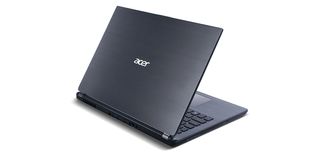MacBook Air Alternatives
As much as Apple would like you to believe the MacBook Air is the only notebook of its kind, there’s a whole world of Ultrabook alternatives out there.
Acer TimelineUltra Offers Something Unique

Generally speaking, Ultrabooks are pretty horrible when it comes to gaming. Even with the added horsepower of the latest Intel HD Graphics 4000 chip, anything other than the lowest quality settings are pretty much out of reach.
Acer designed its latest TimelineUltra M5 series with gaming in mind. It’s by no means a hardcore gaming system, but the Kepler-based Nvidia GeForce GT 640M LE available in some of the M5 configurations is more than spunky enough to play even the latest 3D games (though you’ll have to turn down the settings a bit).
| Acer TimelineUltra | |
|---|---|
| Processor | 3rd Gen Intel Core i5 or Core i7 |
| Graphics | Intel HD Graphics 3000/4000 w/ Nvidia GeForce GT 640M LE (optional) |
| Display | 14 or 15.6-inch 1366x768 |
| I/O Ports & Etc. | 2x USB 3.0, Ethernet, HDMI, SD Reader, DVD-RW, (+1 USB 2.0 for 15-inch) |
| Battery Life | 8 Hours |
| Dimensions (inches) | 14-inch: 13.4 x 9.6 x 0.8; 15-inch: 14.4 x 10.1 x 0.8 |
| Weight | 14-inch: 4.30 Lbs; 15-inch: 5.07 Lbs |
| Price | Starting at $729 |
The added gaming prowess does come with a bit of a sacrifice to portability. Battery life is still solid, with up to 8 hours between charges (obviously that number plummets if you want a cord-free gaming marathon), but the M5 is only offered in 14- and 15.6-inch form factors. Both models stay under the 21 mm (0.827 inches) max thickness required by Intel’s definition of an Ultrabook. They’re also one of the few Ultrabooks on the market that feature an optical drive.

Acer’s entire Ultrabook line, including the M5 and Aspire S3 and S5 series, come in a myriad of configurations. Some features Intel’s 3rd generation Core processors while others sport the older 2nf generation. It’s a similar story with SSD and hybrid hard drives.
One thing they all have in common – and this is another thing Acer is somewhat unique in – is their pricing. Acer’s Ultrabook line is extremely affordable, starting as low as $650. When you look closer, you see that they all feature lower-end 1366x768 resolution displays, and their design generally isn’t quite as robust as some of the offerings from Dell, for example.
Sign up to get the BEST of Tom's Guide direct to your inbox.
Get instant access to breaking news, the hottest reviews, great deals and helpful tips.
Current page: Acer TimelineUltra - MacBook Air Alternatives - Tom’s Guide
Prev Page Asus Zenbook Prime - MacBook Air Alternatives - Tom’s Guide Next Page Samsung Series 9 - MacBook Air Alternatives - Tom’s Guide-
halcyon Very nice. I especially like the Dell, Asus, and Samsung pieces. While I may prefer OS X from a UI standpoint, I love this what these have to offer enough that I'd make the sacrifice.Reply -
fudoka711 While I know many of us like to bash Apple, I like how this article wasn't focusing on why Apple sucks, but instead focused on why the competition is better, or at least probably better to the average consumer. Props to Mr. Escallier for outlining each vendor's pro's/con's in comparison to each other and the MBA.Reply
If I had to choose, I'd get the Zenbook because I love its design and 1080p output. Not gonna be gaming on it, sadly, but watching movies on it would be great. Plus I love the design. -
altriss Replybut it’s really just an “Ultrabook” – a term trademarked and defined by Intel
without beeing specially an Aple fan, I find this stupid. Be honest if Aple hadn't created McBookAir, Intel would never had the Idea of UltraBooks.
By the way I agree with fudoka711 about the general view on this article. Nice to see than PC builders finally created something that is worth a macbook air!
-
unstable hackintosh?its not unstable at all if you know what your doing everything works just fine and app store also so i dont see a problem...Reply
-
quantumrand NotFastEnoughHybrid hard drives negate a lot of what makes the Macbook Air great.Reply
My counter argument: You can go with the Sony Vaio T-Series with a hybrid drive and save $400, taking a small hit in load times for apps you don't use often, or you can go with the T-Series with a SSD and save $200 and get the same SSD performance that "makes the Macbook Air great." :-)
altrisswithout beeing specially an Aple fan, I find this stupid. Be honest if Aple hadn't created McBookAir, Intel would never had the Idea of UltraBooks.
If you want to go with who came first, Gateway had the very first "subnotebook" form factor with the Gateway Handbook back in 1992.
In 2002, Sharp had its Ultranotebook PC-UM20. It used a specialized Ultra-Low Voltage Intel processor (just like today's Ultrabooks) and was only .65 inches thick, thinner than even the current MacBook Air. I'd argue that this was the first "Ultrabook" in the non-Intel defined sense of the term.
In 2004, four years before the MacBook Air, Sony released the PCG-X505. It featured the same processor specs as the full-sized laptops of its time, but was 10.4" laptop that was only 0.8 inches thick.
There was also the Lenovo ThinkPad X300 which was a contemporary of the MacBook Air (released just weeks after the Air) and was actually thinner.
Apple was by no means the pioneer of the Ultrabook platform. The MacBook Air just happened to be the most well-known one. If Apple didn't exist, Intel would still have gone forward with its "Ultrabook" concept. I would absolutely not give Apple credit with coming up with the Ultrabook idea. It gets credit for popularizing it, and that's all. -
DjEaZy ... MacBook Air Alternatives? Without OS X? Except, if you make a hackentoch... but then you can take the original...Reply -
halcyon TBH, while the MacBook Air and its Ultrabook derivatives are nice enough I don't think I'd want to give up any of what my 15" notebook has to offer in terms of performance just to save a few pounds that, by carrying, can only help me stay in better shape than if I were not carrying them. The idea was novel at first and I've had my share of the MacBook Air (I've had 3) and my wife now has one but I'd rather carry my 15" notebook.Reply
